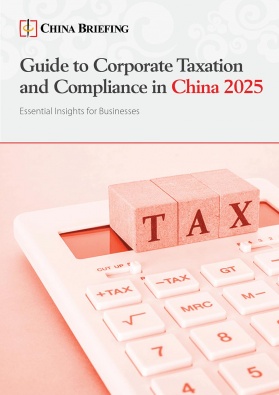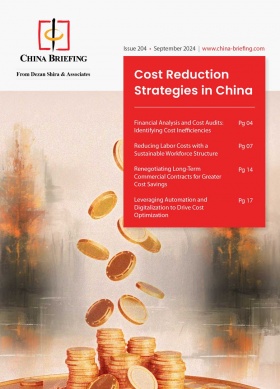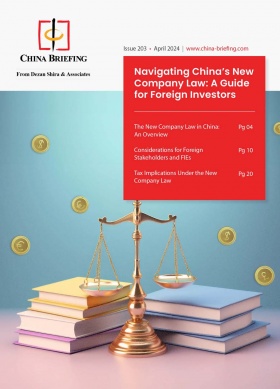China Company Law Follow-Up: Rules Clarified on Use of Reserve Funds, Non-Monetary Capital Contributions
China has released a follow-up to the Company Law that clarifies rules on the use of reserved funds and non-monetary capital contributions, with implications for financial reporting, compliance procedures, and fund management. This article provides detailed guidance to foreign-invested enterprises.
On June 20, 2024, China’s Ministry of Finance issued an important notice, the Notice on Financial Treatment Issues Following the Implementation of the Company Law and Foreign Investment Law. This notice clarifies specific provisions of the amended Company Law, which came into effect on July 1, 2024, as well as the Foreign Investment Law, providing detailed guidance on financial compliance for companies.
Specifically, it clarifies key financial compliance requirements for companies, especially concerning the use of reserve funds to offset losses, rules on non-monetary capital contributions, and the management of reserve-related funds in foreign-invested enterprises (FIEs). It provides details on the required procedures for offsetting losses using capital funds, including internal approvals, creditor notifications, and compliance with asset valuation standards.
Notably, the notice also mandates that starting January 1, 2025, FIEs must cease new allocations to reserve funds, enterprise development funds, and employee incentive and welfare funds, with companies mandated to reverse any such allocations made after that.
Clarifying requirements for the use of reserve funds to offset losses
Article 214 of the amended Company Law stipulates that a company can use its reserve funds to offset its losses, expand its production and operations, or increase its registered capital. If the statutory reserve fund is converted to increase the registered capital, the reserve fund retained must be at least 25 percent of the company’s registered capital before the increase.
The notice clarifies that the amount of losses should be determined based on the audited financial statements from 2024 or later. The funds may only be used to offset the losses to zero, no more than that.
The notice also clarifies that when reserve funds are used to offset losses, first, the discretionary reserve fund must be used, and then the statutory reserve fund. Only if these funds are not sufficient to offset the losses can the capital reserve fund be used.
Capital reserves can only be used to offset losses up to the limit of the net increase in capital reserves by the following actions:
- Accepting capital contributions in the form of currency or non-monetary property such as physical objects, intellectual property rights, land use rights, equity, and debt rights that can be valued in currency and transferred according to law;
- Accepting capital contributions in the form of debt repayment, debt exemption, or donations of currency, physical objects, intellectual property rights, and land use rights.
However, capital reserves restricted for specific shareholders or special purposes cannot be used unless the rightful owner agrees. Capital reserves that are conditional or subject to change cannot be used until the conditions are resolved and the amount is fixed.
Plan for using reserve funds to offset losses
Companies that use reserve funds to offset losses must formulate a plan in which they explain the situation of the losses, the reasons for offsetting the losses, and the sources, amount, and method of the reserve fund to be used to make up for the losses, and so on.
It must then form a board of directors’ resolution, and submit it to the shareholders’ meeting or similar authority for deliberation. Shareholders must inquire and vote in accordance with the law, and if they fail to pass the motion, the company cannot proceed with the offset.
Notifying creditors
Companies that use capital reserve funds to offset losses must either notify creditors or announce the decision to the public within 30 days of the shareholders’ meeting’s resolution. The company’s creditors must make a reasonable assessment of the debt risks.
These provisions do not apply to banking and financial institutions, as they are required to disclose information in accordance with the relevant regulations of the financial regulatory authorities.
When fulfilling the relevant information disclosure obligations, the company must also separately disclose the amount of losses that are offset using the capital reserve funds under the “retained profits” item in the notes to their financial statements.
If a company has used reserve funds to offset losses since the amended Company Law came into effect on July 1, 2024, but the scope and procedures of this action did not meet the requirements set out in the notice, it must make the requisite adjustments to comply with these requirements.
Clarifying rules on non-monetary contributions
Article 48 of the amended Company Law allows shareholders to make capital contributions not only in currency but also through non-monetary assets such as physical goods, intellectual property rights, land use rights, equity interests, and claims, provided these assets can be valued in monetary terms and legally transferred. Assets prohibited by law or administrative regulations may not be used as contributions.
The notice emphasizes that when a company accepts non-monetary contributions from shareholders, it must carry out asset valuation in accordance with the Ministry of Finance and State Administration for Industry and Commerce’s 2009 guidelines (Cai Qi [2009] No. 46). These guidelines require that companies engage qualified asset appraisal institutions, ensure independent and lawful assessments, and prohibit manipulation or interference with the valuation results. Valuation is mandatory not only at the time of initial contribution but also when significant changes in asset conditions or market environment occur.
The company must also follow proper internal decision-making procedures applicable to the relevant corporate action, such as establishment, capital increase, merger, or division.
In addition, companies must assess potential legal and practical risks associated with contributed non-monetary assets, considering their characteristics and possible barriers to realizing ownership or value. Where necessary, companies may obtain legal opinions to ensure the legitimacy and enforceability of these contributions.
Handling the balance of reserve funds, enterprise development funds, and employee incentive and welfare funds
For FIEs organized under the Company Law, the notice clarifies that they must comply with the relevant provisions for statutory and discretionary reserve funds. Specifically, any remaining reserve fund balances are to be transferred and managed as statutory reserve funds, while balances in the enterprise development fund are to be transferred and managed as discretionary reserve funds. FIEs that are not organized as companies should refer to these rules and apply them as appropriate.
Regarding employee incentive and welfare funds, FIEs must use these funds in accordance with the original purpose, conditions, and procedures determined at the time of their allocation. When liquidating the company, the handling of these funds should follow the 1995 liquidation rules for FIEs (Cai Gong Zi [1995] No. 222). These 1995 regulations set out the establishment and duties of liquidation committees, asset management, and debt repayment order during liquidation, as well as rules for handling remaining employee welfare funds.
The notice also stipulates that, starting from January 1, 2025, FIEs should cease new allocations to reserve funds, enterprise development funds, and employee incentive and welfare funds. Any such allocations made after that date must be reversed.
|
China Company Law Follow Up: Rules on Use of Reserve Funds and Non-Monetary Capital Contributions |
||
| Topic | Key Aspects | Description |
| Use of capital and surplus reserves to offset losses | Loss coverage order and limits | Companies may offset accumulated losses using audited financial statements from 2024 onward. The offset must follow this order: discretionary surplus reserves, statutory surplus reserves, and then eligible capital reserves. |
| Capital reserve limits | Only capital reserves generated through specific equity transactions may be used. Reserves with restricted use require consent to be applied. | |
| Corporate governance procedure | A loss recovery plan must be developed, reviewed by the board of directors, and approved by the shareholders’ meeting. Without shareholder approval, reserves cannot be used to offset losses. | |
| Disclosure and creditor notification | Within 30 days of the shareholders’ resolution on offsetting losses with capital reserves, the company shall notify creditors or make a public announcement. Creditors may assess their debt exposure accordingly. | |
| Retroactive compliance | Any reserve-based loss coverage conducted after July 1, 2024, must be reviewed for alignment with the new rules and adjusted if necessary. | |
| Valuation of non-monetary capital contributions | Asset appraisal requirement | When accepting capital contributions in the form of physical goods, IP, equity, or other non-cash assets, companies must conduct an asset appraisal in accordance with Cai Qi [2009] No. 46. |
| Legal risk assessment | Evaluate legal risks affecting contributed assets. Obtain a legal opinion if asset ownership or enforceability is uncertain. | |
| Treatment of legacy reserve and welfare funds in FIEs | Fund reclassification | FIEs that adopt the organizational form, structure, and operational rules governed by the Company Law shall allocate statutory surplus reserves and discretionary surplus reserves. Remaining balances in reserve funds shall be reclassified and managed as statutory surplus reserves, while remaining balances in enterprise development funds shall be reclassified and managed as discretionary surplus reserves. FIEs that are not structured as companies may refer to this treatment for implementation. |
| Employee benefit fund usage | Employee reward and welfare funds in FIEs shall be used according to the purposes, conditions, and procedures defined at the time of allocation. During liquidation, unless such funds must be managed as liabilities under Cai Qi [2006] No. 67, they shall be handled in accordance Cai Gong Zi [1995] No. 222. | |
| Discontinuation of fund accruals | From January 1, 2025 onward, FIEs shall cease the accrual of reserve funds, enterprise development funds, and employee reward and welfare funds. Any such accruals made after January 1, 2025 must be reversed. | |
About Us
China Briefing is one of five regional Asia Briefing publications, supported by Dezan Shira & Associates. For a complimentary subscription to China Briefing’s content products, please click here.
Dezan Shira & Associates assists foreign investors into China and has done so since 1992 through offices in Beijing, Tianjin, Dalian, Qingdao, Shanghai, Hangzhou, Ningbo, Suzhou, Guangzhou, Haikou, Zhongshan, Shenzhen, and Hong Kong. We also have offices in Vietnam, Indonesia, Singapore, United States, Germany, Italy, India, and Dubai (UAE) and partner firms assisting foreign investors in The Philippines, Malaysia, Thailand, Bangladesh, and Australia. For assistance in China, please contact the firm at china@dezshira.com or visit our website at www.dezshira.com.
- Previous Article High-Temperature Allowance in China: FIEs’ Compliance Checklist
- Next Article








